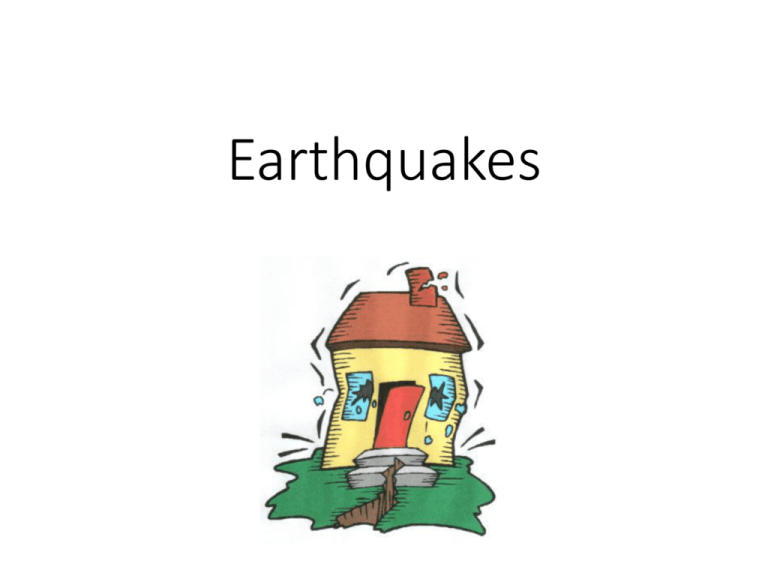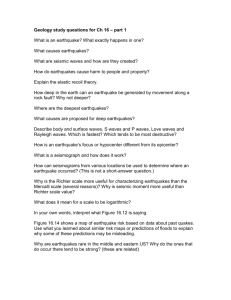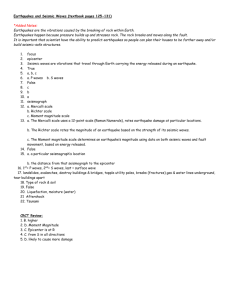Earthquakes
advertisement

Earthquakes What is an earthquake? • Earthquake: a sudden release of energy in earth’s crust that causes movement Why Earthquakes happen • Friction prevents movement along a fault • Fault: a fracture in a rock formation where movements occurs • Sudden release causes a quake Elastic Rebound • Elastic rebound: the sudden return of deformed rock to its original position • Fence offset 8 1/2 feet by main fault in rural California1906. Anatomy of an Earthquake • Focus: the location within Earth along a fault at which the first motion of an Earthquake occurs • The shallower the focus, the more destructive the quake Anatomy of an Earthquake • Epicenter: the location on Earth’s surface directly above the focus Seismic Waves • Seismic Waves: Vibrations caused by earthquakes Body Waves • Body waves: seismic waves that travel through earth’s interior • Two types: • Primary waves: P-waves- Fastest and the first to be detected • Can move through solids, liquids, or gas Body Waves continued • Secondary waves: S-waves- shake the ground back and forth (2nd fastest) • Can move through solids ONLY Animation Surface waves • Surface waves: Only move along the surface of Earth • Slower, but cause the most damage http://www.tjhsst.edu/~jlafever/wanimate/Wave_Properties2.html Surface Waves • Love waves: fastest surface waves • Move rock side to side Diagram of love wave Surface Waves Rayleigh waves: also called a “ground roll” Moves rock in a circular motion Seismic Waves and Earth’s Interior • The composition of the material a seismic wave moves through affect their speed and direction • Andrija Mohorovicic (1909): used seismic waves to find the depth of the mantle Seismic Waves and Earth’s Interior • Shadow Zones: locations on Earth’s surface where no body waves from a particular earthquake can be detected animation Seismic Waves and Earth’s Interior • P-waves are bent as they pass through different layers • S-waves are blocked by the liquid outer core because they can only travel through solids • Activity 1: Seismic Waves • Reflection and extension quiz Studying Earthquakes • Seismograph: an instrument that detects and records seismic waves • Seismogram: the recorded tracing produced by a seismograph Studying Earthquakes (cont.) • Different waves move at different speeds: • P-waves arrive first, then S-waves, then Surface waves Locating an Earthquake • The longer the lag time between P-waves and S-waves, the further away the earthquake is • The location of an earthquake can be found by triangulation: using the distance from 3 stations to find the epicenter of the earthquake http://www.classzone.com/books/ earth_science/terc/content/investi gations/es1003/es1003page02.cfm ?chapter_no=investigation Measuring Earthquakes • Magnitude: the strength of a quake Measuring Earthquakes • Richter Scale: assigns a number to define the energy released during an earthquake https://www.yo utube.com/watc h?v=wVqYg4NP vC4 richter scale explained https://www.y outube.com/w atch?v=1qbg7 orb1lc Bill nye Measuring Earthquakes • Big numbers = stronger earthquakes Taiwan (1999) Measuring Earthquakes • Intensity: the amount of damage caused by an earthquake Tsunamis • http://video.nationalgeographic.com/video/101videos/tsunami-101 Tsunamis • Tsunami: a giant wave caused by an earthquake on the ocean floor Earthquake Safety Earthquake Safety • Earthquakes are more likely to happen in some places, but can happen anywhere • Before: have supplies on hand • Such as: food, water, flash lights, batteries, radios and a first aid kit • During: stand in a doorway, stay away from windows and tall things • Protect your head from falling objects • Drop, Cover and Hold On • After: be cautious of fires, downed powerlines, etc. • Remove yourselves from buildings and check for structural damage. http://www.classzone.com/books/earth_science/terc/content/visualizations/es1005/es1005pag e01.cfm?chapter_no=visualization Earthquake Warnings/Forecasts • Scientists study past quakes to predict where future quakes are most likely to occur • There is No reliable way to predict when or where an earthquake will happen • When stress is building up in rock, sensors can detect tilting and cracking • Foreshocks usually happen before a large earthquake








